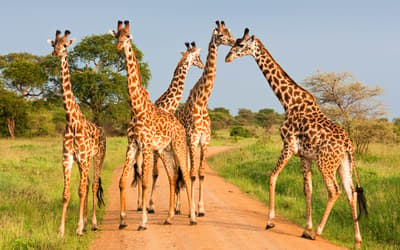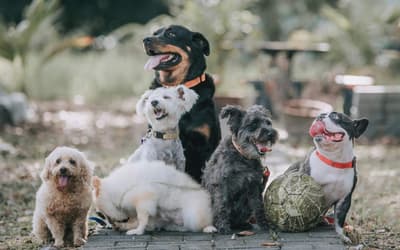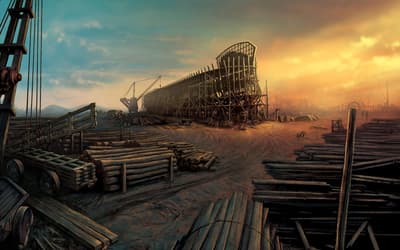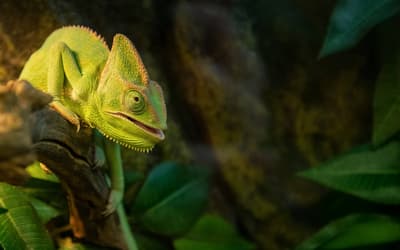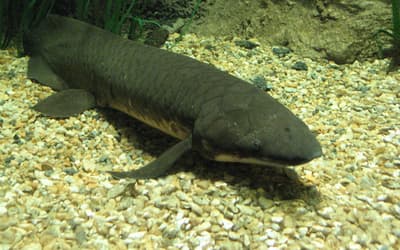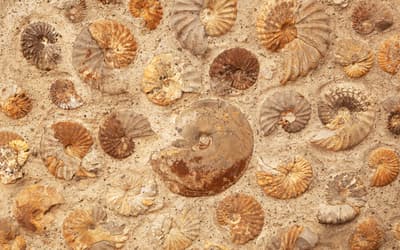Research conducted by Answers in Genesis staff scientists or sponsored by Answers in Genesis is funded solely by supporters’ donations.
Abstract
Information on the class Mammalia was evaluated in an attempt to get a realistic estimate of what mammalian kinds would have been represented on the Ark.
The following are the appendices and references for the paper, Mammalian Ark Kinds:
Appendix 1. Mammalian hybrids—Macropodidae.
| Sthenurinae | ||
|---|---|---|
| Genus | Species | Common Name |
| Lagostrophus | fasciatus | Banded Hair-wallaby |
| Macropodinae | ||
|---|---|---|
| Genus | Species | Common Name |
| Dendrolagus | bennettianus | Bennett’s Tree-kangaroo |
| Dendrolagus | dorianus | Doria’s Tree-kangaroo |
| Dendrolagus | goodfellowi | Goodfellow’s Tree-kangaroo |
| Dendrolagus | inustus | Grizzled Tree-kangaroo |
| Dendrolagus | lumholtzi | Lumholtz’s Tree-kangaroo |
| Dendrolagus | matschiei | Huon Tree-kangaroo |
| Dendrolagus | mbaiso | Dingiso |
| Dendrolagus | pulcherrimus | Golden-mantled Tree-kangaroo |
| Dendrolagus | scottae | Tenkile |
| Dendrolagus | spadix | Lowlands Tree-kangaroo |
| Dendrolagus | stellarum | Seri’s Tree-kangaroo |
| Dendrolagus | ursinus | Ursine Tree-kangaroo |
| Dorcopsis | atrata | Black Dorcopsis |
| Dorcopsis | hageni | White-striped Dorcopsis |
| Dorcopsis | luctuosa | Gray Dorcopsis |
| Dorcopsis | muelleri | Brown Dorcopsis |
| Dorcopsis | macleayi | Macleay’s Dorcopsis |
| Dorcopsis | vanheurni | Small Dorcopsis |
| Lagorchestes | asomatus | Lake Mackay Hare-wallaby |
| Lagorchestes | conspicillatus | Spectacled Hare-wallaby |
| Lagorchestes | hirsutus | Rufous Hare-wallaby |
| Lagorchestes | leporides | Eastern Hare-wallaby |
| Macropus | agilis (3) | Agile Wallaby |
| Macropus | antilopinus | Antilopine Kangaroo |
| Macropus | bernardus | Woodward’s Wallaroo |
| Macropus | dorsalis | Black-striped Wallaby |
| Macropus | eugenii | Tammar Wallaby |
| Macropus | fuliginosus (1, 2) | Western Grey Kangaroo |
| Macropus | giganteus (1, 2) | Eastern Grey Kangaroo |
| Macropus | greyi | Toolache Wallaby |
| Macropus | irma | Western Brush Wallaby |
| Macropus | parma | Parma Wallaby |
| Macropus | parryi (1) | Pretty-faced Wallaby |
| Macropus | robustus (2) | Wallaroo |
| Macropus | rufogriseus (4) | Red-necked Wallaby |
| Macropus | rufus (1, 2) | Red Kangaroo |
| Onychogalea | fraenata | Brindled Nail-tail Wallaby |
| Onychogalea | lunata | Crescent Nail-tail Wallaby |
| Onychogalea | unguifera | Northern Nail-tail Wallaby |
| Petrogale | assimilis (5) | Allied Rock-wallaby |
| Petrogale | brachyotis | Short-eared Rock-wallaby |
| Petrogale | burbidgei | Monjon |
| Petrogale | coenensis | Cape York Rock-wallaby |
| Petrogale | concinna | Nabarlek |
| Petrogale | godmani | Godman’s Rock-wallaby |
| Petrogale | herberti | Herbert’s Rock-wallaby |
| Petrogale | inornata (5) | Unadorned Rock-wallaby |
| Petrogale | lateralis | Black-flanked Rock-wallaby |
| Petrogale | mereeba (5) | Mareeba Rock-wallaby |
| Petrogale | penicillata | Brush-tailed Rock-wallaby |
| Petrogale | persephone | Proserpine Rock-wallaby |
| Petrogale | purpureicollis | Perple-necked Rock-wallaby |
| Petrogale | rothschildi | Rothschild’s Rock-wallaby |
| Petrogale | sharmani (5) | Mt. Claro Rock-wallaby |
| Petrogale | xanthopus | Yellow-footed Rock-wallaby |
| Setonix | brachyurus | Quokka |
| Thylogale | billardierii | Tasmanian Pademelon |
| Thylogale | browni | Brown’s Pademelon |
| Thylogale | brunii | Dusky Pademelon |
| Thylogale | calabyi | Calaby’s Pademelon |
| Thylogale | lanatus | Mountain Pademelon |
| Thylogale | stigmatica (4) | Red-legged Pademelon |
| Thylogale | thetis (4) | Red-necked Pademelon |
| Wallabia | bicolor (3) | Swamp Wallaby |
(1) The Eastern Grey Kangaroo has crossed with the Western Grey Kangaroo, the Pretty-faced Wallaby, and the Red Kangaroo (Gray 1972, pp. 167–168).
(2) The Red Kangaroo, in addition to hybridizing the the Eastern (#1) and Western Grey Kangaroos, has hybridized with the Walaroo (Gray 1972, p. 168).
(3) The Agile Wallaby has crossed with the Swamp Wallaby (VanGelder 1977, pp. 5–6). Mentioned in Gary (1972) with both under the genus name Wallabia (pp. 169–170).
(4) The Red-necked Pademelon has hybridized with the Red-legged Pademelon and the Red-necked Wallaby (Bennet’s Wallaby in Gray) (Gray 1972, p. 169).
(5) Crosses have been produced between the Allied Rock-wallaby and the Unadorned, Mareeba, and Mt. Claro Rock-wallabies (Close et al. 1996). Each of these species differ in karyotype.
Appendix 2. Mammalian hybrids—Elephantidae.
| Genus | Species | Common Name |
|---|---|---|
| Elephus | maximus (1) | Asian Elephant |
| Loxodonta | africana (1) | African Bush Elephant |
| Loxodonta | cyclotis | African Forest Elephant |
(1) An Asian elephant gave birth to a male calf, Motty, at Chester Zoo in England in 1978; the sire was an African elephant (http://www.elephant.se/Motty_the_elephant_crossbreed.php)
For many years the African Bush and Forest Elephants were considered different subspecies of L. africana.
Appendix 3. Mammalian hybrids—Cercopithecidae.
| Cercopithecinae | ||
|---|---|---|
| Genus | Species | Common Name |
| Allenopithecus | nigroviridis (1) | Allen’s Swamp Monkey |
| Cercocebus | 6 species (2, 3) | Mangabeys |
| Cercopithecus | 25 species (1, 4, 5) | various Monkeys and Guenons |
| Chlorocebus | 6 species | various Monkeys and Vervet |
| Erythrocebus | patas (5) | Patas Monkey |
| Lophocebus | 3 species | various Mangabeys |
| Macaca | 21 species (2, 4) | Macaque |
| Mandrillus | 2 species (3, 6) | Mandrills |
| Miopithecus | 2 species | Talapoin |
| Papio | 5 species (6, 7) | Baboon |
| Theropithecus | gelada (7) | Gelada |
| Colobinae | ||
|---|---|---|
| Genus | Species | Common Name |
| Colobus | 5 species | Colobuses |
| Nasalis | larvatus | Proboscis Monkey |
| Piliocolobus | 9 species | other Colobuses |
| Presbytis | 10 species | Surilis and Langurs |
| Procolobus | verus | Olive Colobus |
| Pygathrix | 3 species | Douc Langurs |
| Rhinopithecus | 4 species | Snub-nosed Monkeys |
| Semnopithecus | 7 species | Gray Langurs |
| Simias | cancolor | Simakobou |
| Trachypithecus | 17 species | Lutungs, Leaf-monkeys, and other Langurs |
(1) Allenopithecus nigroviridis has crossed with Cercopithecus aethiops producing viable offspring (Van Gelder 1977).
(2) Two species of Cercocebus have each crossed with two species of Macaca (Van Gelder 1977).
(3) There are two reported cases of Cercocebus crossing with Mandrillus, resulting in live birth (Van Gelder 1977).
(4) Several species of Cercopithecus have been crossed succesfully with several species of Macaca (Van Gelder 1977).
(5) A hybrid was produced between one species of Cercopithecus and Erythrocebus patas (Van Gelder 1977).
(6) Several species of Mandrillus have hybridized with various species from Papio (Van Gelder 1977).
(7) Theropithecus gelada has hybridized with Papio (Van Gelder 1977).
Appendix 4. Mammal hybrids—Sciuridae.
| Genus | Species | Common Name |
|---|---|---|
| Ratufa | 4 species | Giant Squirrels |
| Sciurillus | pusillus | Neotropical Pygmy Squirrel |
| Microsciurus | 4 species | Dwarf Squirrels |
| Rheithrosciurus | macrotis | Tufted Ground Squirrel or Groove-toothed Squirrel |
| Sciurus | 28 species | Tree Squirrels |
| Syntheosciurus | brochus | Bang’s Mountain Squirrel |
| Tamiasciurus | 3 species (2) | Red Squirrels or Chickarees |
| Aeretes | melanopterus | Northern Chinese Flying Squirrel or Groove-toothed Flying Squirrel |
| Aeromys | 2 species | Large Black Flying Squirrels |
| Belomys | pearsonii | Hairy-footed Flying Squirrel |
| Biswamoyopterus | biswasi | Namdapha Flying Squirrel |
| Eoglaucomys | fimbriatus | Kashmir Flying Squirrel |
| Eupetaurus | cinereus | Woolly Flying Squirrel |
| Glaucomys | 2 species | New World Flying Squirrels |
| Hylopetes | 9 species | Arrow-tailed Flying Squirrels |
| Iomys | 2 species | Horsfield’s Flying Squirrels |
| Petaurillus | 3 species | Pygmy Flying Squirrels |
| Petaurista | 8 species | Giant Flying Squirrels |
| Petinomys | 9 species | Dwarf Flying Squirrels |
| Pteromys | 2 species | Old World Flying Squirrels |
| Pteromyscus | pulverulentus | Smoky Flying Squirrel |
| Trogopterus | xanthipes | Complex-toothed Flying Squirrels |
| Callosciurus | 15 species | Beautiful Squirrels or Tricolored Squirrels |
| Dremomys | 6 species | Red-cheeked Squirrels |
| Exilisciurus | 3 species | Pygmy Squirrels |
| Funambulus | 5 species | Asiatic Striped Palm Squirrels |
| Glyphotes | simus | Bornean Pygmy Squirrel or Sculptor Squirrel |
| Hyosciurus | 2 species | Sulawesi Long-nosed Squirrels |
| Lariscus | 4 species | Malaysian Striped Ground Squirrels |
| Menetes | berdmorei | Berdmore’s or Multistriped Palm Squirrel |
| Nannosciurus | melanotis | Black-eared Squirrel |
| Prosciurillus | 5 species | Sulawesi Dwarf Squirrels |
| Rhinosciurus | laticaudatus | Long-nosed Squirrel or Shrew-faced Squirrel |
| Rubrisciurus | rubriventer | Sulawesi Giant Squirrel |
| Sundasciurus | 15 species | Sunda Tree Squirrels |
| Tamiops | 4 species | Asiatic Striped Squirrel |
| Atlantoxerus | getulus | Barbary Groud Squirrel |
| Spermophilopsis | leptodactylus | Long-clawed Ground Squirrel |
| Xerus | 4 species | African Ground Squirrels |
| Epixerus | ebii | African Palm Squirrels |
| Funisciurus | 9 species | African Striped Squirrels or Rope Squirrels |
| Heliosciurus | 6 species | Sun Squirrels |
| Myosciurus | pumilio | African Pygmy Squirrel |
| Paraxerus | 11 species | African Bush Squirrels |
| Protoxerus | 2 species | Oil Palm Squirrels |
| Ammospermophilus | 5 species | Antelope Ground Squirrels |
| Cynomys | 5 species | Prairie Dogs |
| Marmota | 14 species (3) | Marmots |
| Sciurotamias | 2 species | Rock Squirrels |
| Spermophilus | 41 species (1) | Ground Squirrels or Susliks |
| Tamias | 25 species | Chipmunks |
(1) There is abundant evidence of interspecific hybridization among members of this genus in contact zones (Cothran and Honeycutt
1984; Ermakov et al. 2002; Goodwin 1998; Hafner 1992; Spiridonova et al. 2006; Tsvirka, Chelomina, and Korablev 2006). Gray (1972) has some listed under the (invalid) genus name Citellus.
(2) There is evidence of hybridization between Tamiasciurus douglasii and T. hudsonicus in a contact zone (Chavez, Saltzberg, and Kenagy 2011).
(3) There is evidence of hybridization between Marmota baibacina and M. sibirica in a contact zone (Brandler, Nikol’sky, and Kolesnikov 2010).
Appendix 5. Mammal hybrids—Geomyidae.
| Genus | Species | Common Name |
|---|---|---|
| Cratogeomys | 8 species | Yellow-faced and Mexican Pocket Gophers |
| Geomys | 9 species (1) | Eastern Pocket Gophers |
| Orthogeomys | 11 species | Taltuzas |
| Pappogeomys | 2 species | Alcorn’s and Buller’s Pocket Gophers |
| Thomomys | 8 species (2) | Western Pocket Gophers |
| Zygogeomys | trichopus | Michoacan Pocket Gopher |
(1) Hybrids have been reported in contact zones between several different species in Geomys (Harrison 1993).
(2) Hybrids have been reported in contact zones between Thomomys townsendii x T. umbrinus (Gray 1972, pp. 63–64).
Appendix 6. Mammal hybrids—Leporidae.
| Genus | Species | Common Name |
|---|---|---|
| Brachylagus | idahoensis | Pygmy Rabbit |
| Bunolagus | monticularis | Riverine Rabbit |
| Caprolagus | hispidus | Hispid Hare |
| Lepus | 32 species (1, 2) | Common Hares and Jackrabbits |
| Nesolagus | 2 species | Striped Rabbits |
| Oryctolagus | cuniculus (2) | European Rabbit |
| Pentalagus | furnessi | Amami Rabbit |
| Poelagus | majorita | Bunyoro Rabbit |
| Pronolagus | 3 species | Red Rock Hares |
| Romerolagus | diazi | Volcano Rabbit |
| Sylvilagus | 17 species | Cottontails |
(1) Hybrids have been reported between L. europaeus (European Hare) and L. timidus (Mountain Hare) (Gray 1972, pp. 90–91).
(2) Live hybrids are claimed between Lepus species and O. cuniculus (European rabbit), but not well documented. One well documented case of development past the blastocyst stage and implantation has been recorded (Chang, Marston and Hunt 1964; Gray 1972, pp. 91–92).
Appendix 7. Mammal hybrids—Felidae.
| Felinae | ||
|---|---|---|
| Genus | Species | Common Name |
| Acinonyx | jubatus | Cheetah |
| Caracal | caracal | Caracal |
| Catopuma | badia | Bay Cat |
| Catopuma | temminckii | Asian Golden Cat |
| Felis | beiti | Chinese Mountain Cat |
| Felis | catus (3) | Domestic Cat |
| Felis | chaus (3) | Jungle Cat |
| Felis | manul | Palla’s Cat |
| Felis | margarita | Sand Cat |
| Felis | nigripes | Blackfooted Cat |
| Felis | silvestris (3) | Wildcat |
| Leopardus | 9 species (4) | includes ocelot |
| Leptailurus | serval | Serval |
| Lynx | canadensis | Canadian Lynx |
| Lynx | lynx | Eurasian Lynx |
| Lynx | pardinus | Iberian Lynx |
| Lynx | rufus (3) | Bobcat |
| Pardofelis | marmorata | Marbled Cat |
| Prionailurus | bengalensis (3) | Leopard Cat |
| Prionailurus | iriomotensis | Iriomote Cat |
| Prionailurus | planiceps | Flat-headded Cat |
| Prionailurus | rubiginosus | Rusty-Spotted Cat |
| Prionailurus | viverrinus | Fishng Cat |
| Profelis | aurata | African Golden Cat |
| Puma | concolor (1, 4) | Cougar |
| Puma | yagouaroundi | Jaguarundi |
| Pantherinae | ||
|---|---|---|
| Genus | Species | Common Name |
| Neofelis | nebulosa | Clouded Leopard |
| Panthera | leo (2) | Lion |
| Panthera | onca | Jaguar |
| Panthera | pardus (1, 2) | Leopard |
| Panthera | tigris (2) | Tiger |
| Uncia | uncia | Snow Leopard |
(1) Reciprocal crossed have occurred between the Cougar and the Leopard (Gray 1972, pp. 37–38).
(2) Lions have crossed with both leopards and tigers (Gray 1972, pp. 39–40).
(3) The domestic cat is reported to have crossed with the Jungle Cat, European Wild Cat, Bobcat, and Leopard Cat (Gray 1972, pp. 35–37.
(4) The ocelot (Leopardus pardalis) has crosses with the Cougar (Puma concolor) (Dubost and Royère 1993).
Appendix 8. Mammal hybrids—Canidae.
| Genus | Species | Common Name |
|---|---|---|
| Atelocynus | microtis | Short-eared Dog |
| Canis | adustus | Side-striped Jackal |
| Canis | aureus (1) | Golden Jackal |
| Canis | latrans (1, 4) | Coyote |
| Canis | lupus (1) | Wolf |
| Canis | mesomelas | Black-backed Jackal |
| Canis | simensis | Ethiopian Wolf |
| Cerdocyon | thous | Crab-eating Fox |
| Chrysocyon | brachyurus | Maned Wolf |
| Cuon | alpinus | Dhole |
| Dusicyon | australis | Falkland Islands Wolf |
| Lycalopex | culpaeus | Culpeo |
| Lycalopex | fulvipes | Darwin’s Fox |
| Lycalopex | griseus | South American Gray Fox |
| Lycalopex | gymnocercus | Pampas Fox |
| Lycalopex | sechurae | Sechuran Fox |
| Lycalopex | vetulus | Hoary Fox |
| Lycaon | pictus | African wild dog |
| Nyctereutes | procyonoides | Raccoon dog |
| Otocyon | megalotis | Bat-eared Fox |
| Speothos | venaticus | Bush Dog |
| Urocyon | cinereoargenteus | Gray Fox |
| Urocyon | littoralis | Island Fox |
| Vulpes | bengalensis | Bengal Fox |
| Vulpes | cana | Blanford’s Fox |
| Vulpes | chama | Cape Fox |
| Vulpes | corsac | Corsac Fox |
| Vulpes | ferrilata | Tibetan Sand Fox |
| Vulpes | lagopus (2) | Arctic Fox |
| Vulpes | macrotis (3) | Kit Fox |
| Vulpes | pallida | Pale Fox |
| Vulpes | rueppellii | Rüppell’s Fox |
| Vulpes | velox (3) | Swift Fox |
| Vulpes | vulpes (2, 4) | Red Fox |
| Vulpes | zerda | Fennec Fox |
(1) Well documented hybrids with domestic dogs (Canis familiaris) (Gray 1972, pp. 46–47).
(2) The Arctic Fox has hybridized with both the Red Fox, and the color variant called the Silver Fox (formerly Vulpes fulva) (Gray 1972, pp. 44–45).
(3) Hybridization inferred from intermediate skull morphology found in region where species overlap (Rohwer and Kilgore 1973).
(4) A zoo hybrid documented in International Zoo Yearbook 15, Duplaix-Hal (1975, p. 372). Further documentation in VanGelder (1977, p. 10).
Appendix 9. Mammal hybrids—Ursidae.
| Genus | Species | Common Name |
|---|---|---|
| Ailuropoda | melanoleuca | Giant Panda |
| Helarctos | malayanus (1) | Sun Bear |
| Melurus | ursinus (1) | Sloth Bear |
| Tremarctos | ornatus (3) | Spectacled Bear |
| Ursus | americanus (2) | American Black Bear |
| Ursus | arctos (2) | Brown Bear |
| Ursus | maritimus (2) | Polar Bear |
| Ursus | thibetanus (1, 2, 3) | Asian Black Bear |
(1) The Sun Bear has hybridized with both the Sloth Bear and the Asian Black Bear (Hennigan 2009).
(2) The Brown Bear has hybridized with the American Black Bear, Polar Bear, and Asian Black Bear (Hennigan 2009).
(3) The Asian Black Bear has hybridized with the Spectacled Bear (Hennigan 2009).
Appendix 10. Mammal hybrids—Equidae.
| Genus | Species | Common Name |
|---|---|---|
| Equus | asinus (1) | Ass |
| Equus | burchellii (1) | Burchell’s Zebra |
| Equus | caballus (1) | Horse |
| Equus | grevyi (1) | Grévy’s Zebra |
| Equus | hemionus (1) | Onager |
| Equus | kiang (1) | Kiang |
| Equus | quagga (1?, 2) | Quagga |
| Equus | zebra (1, 2) | Mountain Zebra |
(1) Crosses have been reported between the Ass and all other equine species. The cross between the Ass and the Quagga (now extinct) has been questioned (Gray 1972, pp. 94–101).
(2) The Quagga has been involved other crosses that are not questionable accorording to Gray, including with the Mountain Zebra (Gray 1972, p. 112).
Appendix 11. Mammal hybrids—Tapiridae.
| Genus | Species | Common Name |
|---|---|---|
| Tapirus | bairdii (1) | Baird’s Tapir |
| Tapirus | indicus | Malayan Tapir |
| Tapirus | pinchaque | Mountain Tapir |
| Tapirus | terrestris (1) | South American Tapir |
(1) Crosses have occurred between the Baird’s and South American Tapirs at the San Francisco Zoo (Anonymous n.d.).
Appendix 12. Mammal hybrids—Rhinocerotidae.
| Genus | Species | Common Name |
|---|---|---|
| Ceratotherium | simum (1) | White Rhinoceros |
| Dicerorhinus | sumatrensis | Sumatran Rhinoceros |
| Diceros | bicornis (1) | Black Rhinoceros |
| Rhinoceros | sondaicus | Javan Rhinoceros |
| Rhinoceros | unicornis | Indian Rhinoceros |
(1) A hybrid between a white and a black rhinoceros has been confirmed (Robinson et al 2005).
References
Adams, S.M., J. Biazik, R. L. Stewart, C. R. Murphy, and M. B. Thompson. 2007. Fundamentals of viviparity: Comparison of seasonal changes in the uterine epithelium of oviparous and viviparous Lerista bougainvillii (Squamata: Scincidae). Journal of Morphology 268, no. 7:624–635.
Alzola, R. H., M. D. Ghezzi, E. J. Gimeno, M. C. Lupido, A. N. Castro, and J. A. Rodríguez. 2004. Topography and morphology of the llama (Lama glama) stomach. International Journal of Morphology 22, no. 2:155–164.
Anonymous. n. d. Retrieved from, http://www.tapirback.com/tapirgal/tbtap015.htm.
Aplin, K. P., K. M. Helgen, and D. P. Lunde. 2010. A review of Peroryctes broadbenti, the giant bandicoot from Papua New Guinea. American Museum novitates, no. 3696.
Archer, M., and J. A. W. Kirsch. 1977. The case for the Thylacomyidae and Myrmecobiidae, Gill, 1872, or why are marsupial families so extended? Proceedings of the Linnean Society of New South Wales 102:18–25.
Arrayago, M., A. Bea, and B. Heulin. 1996. Hybridization experiment between oviparous and viviparous strains of Lacerta vivipara: A new insight into the evolution of viviparity in reptiles. Herpetologica 52, no. 3:333–342.
Bacquet, C., T. Imamura, C. A. Gonzalez, I. Conejeros, G. Kausel, T. M. Neildez-Nguyen, A. Paldi, and M. H. Gallardo. 2008. Epigenetic processes in a tetraploid mammal. Mammalian Genome 19, no. 6:439–447.
Beech, S. 2012. Terrestrial vertebrate families on Noah’s Ark. Honors thesis, Liberty University.
Benedict, F. G. and R. C. Lee. 1936. Studies on the body temperature of elephants. Proceedings of the National Academy of Sciences of the United States of America 22, no. 6:405–408. Retrieved from http://www.pnas.org/content/22/6/405.full pdf.
Benedict, R.A. 1999. Morphological and mitochondrial DNA variation in a hybrid zone between short-tailed shrews (Blarina) in Nebraska. Journal of Mammology 80, no 1:112–134.
Bosma, A. A., N. A. de Haan, G. J. Arkesteijn, F. Fang, M. Yerle, and C. Zijlstra. 2004. Comparative chromosome painting between the domestic pig (Sus scrofa) and two species of peccary, the collared peccary (Tayassu tajacu) and the white-lipped peccary (T. pecari): A phylogenetic perspective. Cytogenetic and Genome Research 105, no. 1:115–121.
Brandler, O. V., A. A. Nikol’sky, and V. V. Kolesnikov. 2010. Spatial distribution of Marmota baibacina and M. sibirica (Marmota, Sciuridae, Rodentia) in a zone of sympatry in Mongolia Altai: Bioacoustics analysis. Biology Bulletin 37, no. 3:321–325.
Brown, J. D., V. Piccuillo, and R. J. O’Neill. 2012. Retroelement demethylation associated with abnormal placentation in Mus musculus × Mus caroli hybrids. Biology of Reproduction 86, no 3:88.
Burt, M. S. and R. C. Dowler. 1999. Biochemical systematics of Geomys breviceps and two chromosomal races of Geomys attwateri in Eastern Texas. Journal of Mammology 80, no. 3:799–809.
Carraway, L. N. and B. J. Verts. 1993. Aplodontia rufa. Mammalian Species 431:1–10. Retrieved from http://www.science.smith.edu/msi.
Carter, A. M. and A. C. Enders. 2010. Placentation in mammals once grouped as insectivores. The International Journal of Developmental Biology 54, no. 2–3:483–493.
Carter, G. G. and D. K. Riskin. 2006. Mystacina tuberculata. Mammalian Species 790:1–8. Retrieved from http://www.science.smith.edu/msi.
Cavanaugh, D. P., T. C. Wood, and K. P. Wise. 2003. Fossil Equidae: a monobaraminic, stratomorphic series. In Proceedings of the fifth international conference on creationism, ed. R. L. Ivey, pp. 143–153. Pittsburgh, Pennsylvania: Creation Science Fellowship.
Chang, M. C., J. H. Marston, and D. M. Hunt. 1964. Reciprocal fertilization between the domesticated rabbit and the snowshoe hare with special reference to insemination of rabbits with an equal number of hare and rabbit spermatozoa. Journal of Experimental Zoology 155:437–446.
Chang, M. C. 1965. Implantation of ferret ova by mink sperm. Journal of Experimental Zoology 160, no. 1:67–79.
Chang, M. C. 1968. Reciprocal insemination and egg transfer between ferrets and mink. Journal of Experimental Zoology 168, no. 1:49–59.
Chavez, A. S., C. J. Saltzberg, and G. J. Kenagy. 2011. Genetic and phenotypic variation across a hybrid zone between ecologically divergent tree squirrels (Tamiasciurus). Molecular Ecology 20, no. 16:3350–3366.
Close, R. L. and P. S. Lowry. 1990. Hybrids in marsupial research. Australian Journal of Zoology 37, no. 3:259–267.
Close, R. L., J. N. Bell, A. E. Dollin, and H. R. Harding. 1996. Spermatogenesis and synaptonemal complexes of hybrid Petrogale (Marsupialia). The Journal of Heredity 87, no 2:96–107.
Close, R. L. and J. N. Bell. 1997. Fertile hybrids in two genera of wallabies: Petrogale and Thylogale. The Journal of Heredity 88, no. 5:393–397.
Corbin, C. J., A. L. Hughes, J. R. Heffelfinger, T. Berger, T. B. Waltzek, J. F. Roser, T. C. Santos, et al. 2007. Evolution of Suiform aromatases: Ancestral duplication with conservation of tissue-specific expression in the collared peccary (Pecari tayassu). Journal of Molecular Evolution 65, no. 4:403–412.
Cothran, E. G. and R. L. Honeycutt. 1984. Chromosomal differentiation of hybridizing ground squirrels (Spermophilus mexicanus and S. tridecemlineatus). Journal of Mammology 65, no. 1:118–122.
Davis, E. B., K. A. Brakora, and A. H. Lee. 2011. Evolution of ruminant headgear: A review. Proceedings of the Royal Society B 278, no. 1720:2857–2865.
Delmore, K. E., E. E. Louis Jr., and S. E. Johnson. 2011. Morphological characterization of a brown lemur hybrid zone (Eulemur rufifrons × E. cinereiceps). American Journal of Physical Anthropology 145, no 1:55–66.
Dewey, T. 2007. Pitheciidae. Retrieved from http://animaldiversity.ummz.umich.edu/site/accounts/information/Pitheciidae.html on May 24, 2012.
Dubost, G. and J. Royère. 1993. Hybridization between ocelot (Felis pardalis) and Puma (Puma concolor). Zoo Biology 12, no. 3:277–283.
Duplaix-Hall, ed. 1975. International zoo yearbook vol. 15. London, United Kingdom: The Zoological Society of London.
Duselis, A. R. and P. B. Vrana. 2010. Aberrant growth and pattern formation in Peromyscus hybrid placental development. Biology of Reproduction 83, no. 6:988–996.
Ermakov, O. A., V. L. Surin, S. V. Titov, A. F. Tagiev, A. V. Luk’ianenko, and N. A. Formozov. 2002. Study of hybridization in four species of ground squirrels (Spermophilus: Rodentia, Sciuridae) by molecular genetic methods. (Article in Russian). Genetika 38, no. 7:950–964.
Frost, D. R., W. C. Wozencraft, and R. S. Hoffman. 1991. Phylogenetic relationships of hedgehogs and gymnures (Mammalia: Insectivora: Erinaceidae). Smithsonian Contributions to Zoology 518. Washington D.C., United States of America: Smithsonian Institution Press. Retrieved from http://si-pddr.si.edu/jspui/bitstream/10088/5156/2/SCtZ-0518-Lo_res.pdf.
Gallardo, M. H., G. Kausel, A. Jiménez, C. Bacquet, C. González, J. Figueroa, N. Köhler, and R. Ojeda. 2004. Whole-genome duplications in South American desert rodents (Octodontidae). Biological Journal of the Linnean Society 82:443–451.
Gilbert, C., P. C. O’Brien, G. Bronner, F. Yang, A. Hassanin, M. A. Ferguson-Smith, and T. J. Robinson. 2006. Chromosomal painting and molecular dating indicate a low rate of Chromosomal evolution in golden moles (Mammalia, Chrysochloridae). Chromosome Research 14, no. 8:793–803.
Gilbert, C., S. M. Goodman, V. Soarimalala, L. E. Olson, P. C. O’Brien, F. F. Elder, F. Yang, M. A. Ferguson-Smith, and T. J. Robinson. 2007. Chromosomal evolution in tenrecs (Microgale and Oryzorictes, Tenrecidae) from the Central Highlands of Madagascar. Chromosome Research 15, no. 8:1075–1091.
Goodwin, H. T. 1998. Supernumerary teeth in Pleistocene, recent, and hybrid individuals of the Spermophilus richardsonii complex (Sciuridae). Journal of Mammology 79, no 4:1161–1169.
Gray, A. P. 1972. Mammalian hybrids. Farnham Royal, England: Commonwealth Agricultural Bureaux.
Hafner, D. J. 1992. Speciation and persistence of a contact zone in Mojave Desert ground squirrels, subgenus Xerospermophilus. Journal of Mammology 73, no 4:770–778.
Harris, J. M. 2008. Cercartetus nanas (Diprotodontia: Burramyidae). Mammalian Species 815:1–10.
Harrison, R. G. ed. 1993. Hybrid zones and the evolutionary process. New York, New York: Oxford University Press.
Hartwig-Scherer, S. 1993. Hybridisierung und artbildung bei den Meerkatzenartigen (Primates, Cercopithecoidea). In Typen des lebens, ed. S. Scherer, pp. 245–257. Berlin, Germany: Pascal-Verlag.
Heath, M. E. 1992. Manis pentadactyla. Mammalian species 414:1–6. Retrieved from http://www.science.smith.edu/msi.
Hennigan, T. 2009. Interpreting an unusual Arctic bear within a creation model of origins. Answers in Depth 4. Retrieved from http://www.answersingenesis.org/articles/aid/v4/n1/grolar-bear.
Hennigan, T. 2010. The case for holobaraminic status in bears (family Ursidae) and the implications within a creation model of ecology. Creation Research Society Quarterly 46, no 4:271–283.
Huffman 2011. www.ultimateungulate.com: Your Guide to the World’s Hoofed Mammals. Retrieved August 15, 2012, from http://www.ultimateungulate.com/Cetartiodactyla.html.
Hume, I. D. 1999. Marsupial nutrition. Cambridge, United Kingdom: Cambridge University Press.
Kirsch, J. A. W. 1977. The comparative serology of marsupials, and a classification of marsupials. Australian Journal of Zoology Supplementary Series 25, no. 52:1–152.
Larsen, P. A., M. R. Marchán-Rivadeneira, and R. J. Baker. 2010. Natural hybridization generated mammalian lineage with species characteristics. Proceedings of the National Academy of Sciences of the United States of America 107, no. 25:11447–11452.
Lightner, J. K. 2006a. Changing chromosome numbers. Journal of Creation 20, no. 3:14–15. Lightner, J. K. 2006b. The baraminic status of the family Cervidae as determined using interspecific hybrid data. Occasional papers of the BSG 8:12–13. Retrieved from http://documents.clubexpress.com/documents.ashx?key=6FyKwSXHsz57v8ZJrts8fEYrGdpU%2f0FGieqqw2QiS0A%3d.
Lightner, J. K. 2006c. Identification of species within the sheep-goat kind (Tsoan monoaramin). Journal of Creation 20, no. 3:61–65.
Lightner, J. K. 2007. Identification of species within the cattle monobaramin (kind). Journal of Creation 21, no. 1:119–122.
Lightner, J. K. 2009. Gene duplications and nonrandom mutations in the family Cercopithecidae: evidence for designed mechanisms driving adaptive genomic mutations. Creation Research Society Quarterly 46, no. 1:1–5.
Lightner, J. K., T. Hennigan, and G. Purdom. 2011. Determining the Ark kinds. Answers Research Journal 4:195–201..
Lodé, T., G. Guiral, and D. Peltier. 2005. European mink-polecat hybridization events: Hazards from natural processes? Journal of Heredity 96, no. 2:89–96.
Marshall, L. G. 1978. Glironia venusta. Mammalian Species 107:1–3. Retrieved from http://www.science.smith.edu/msi.
Marshall, C. D. and J. F. Eisenberg. 1996. Hemicentetes semispinosus. Mammalian Species 541:1–4. Retrieved from http://www.science.smith.edu/msi.
McBee, K. and R. J. Baker. 1982. Dasypus novemcinctus. Mammalian Species 162:1–9. Retrieved from http://www.science.smith.edu/msi.
McKenna, M. C. and S. K. Bell. 1997. Classification of mammals: Above the species level. New York, New York: Columbia University Press.
Meredith, R. W., M. Westerman, and M. S. Springer. 2009. A phylogeny of Diprotodontia (Marsupialia) based on sequences for five nuclear genes. Molecular Phylogenetics and Evolution 51, no. 3:554–571.
Moeller, D. 2004. The effect of design constraints on the plasticity of traits within a baramin: Echolocation, flight and masticatory systems in Chiroptera. Occasional Papers of the Biology Study Group 4:15; Retrieved from http://documents.clubexpress.com/documents.ashx?key=BiQ8jmi1eERm13DEVNiANPYDZZPDqT5GFA1j2fGAYbE%3d.
Molén, M. 2009. The evolution of the horse. Journal of Creation 23, no. 2:59–63.
Munemasa, M., M. Nikaido, S. Donnellan, C. C. Austin, N. Okada, and M. Hasegawa. 2006. Phylogenetic analysis of diprotodontian marsupials based on complete mitochondrial genomes. Genes and Genetic Systems 81, no. 3:181–191.
Nachman, M. W., and P. Myers. 1989. Exceptional chromosomal mutations in a rodent population are not strongly underdominant. Proceedings of the National Academy of Sciences of the United States of America 86, no. 17:6666–6670.
Nishihara, H., M. Hasegawa, and N. Okada. 2006. Pegasoferae, an unexpected mammalian clade revealed by tracking ancient retroposon insertions. Proceedings of the National Academy of Sciences of the United States of America 103, no. 26:9929–9934.
Nowak, R. M. 1999. Walker’s mammals of the world, 6th ed. 2 vols. Baltimore, Maryland: The Johns Hopkins University Press.
Nowak, R. M. 2003. Walker’s marine mammals of the world. Baltimore, Maryland: The Johns Hopkins University Press.
Nowak, R. M. 2005a. Walker’s marsupials of the world. Baltimore, Maryland: The Johns Hopkins University Press.
Nowak, R. M. 2005b. Walker’s carnivores of the world. Baltimore, Maryland: The Johns Hopkins University Press.
Oard, M. 2004. Frozen in time. Green Forest, Arkansas: Master Books.
Pasitschniak-Arts, M and L. Marinelli. 1998. Ornithorhynchus anatinus. Mammalian Species 585:1–9. Retrieved from http://www.science.smith.edu/msi.
Pastorini, J, A. Zaramody, D.J. Curtis, C.M. Nievergelt, and N. I. Mundy. 2009. Genetic analysis of hybridization and introgression between wild mongoose and brown lemurs. BMC Evolutionary Biology 9:32.
Patterson, B. D. and M. H. Gallardo. 1987. Rhyncholestes raphanurus. Mammalian Species 286:1–5. Retrieved from http://www.science.smith.edu/msi.
Pendragon, B. 2011. A review of selected features of the family Canidae with reference to its fundamental taxonomic status. Journal of Creation 25, no. 3:79–88.
Pendragon, B. and N. Winkler. 2011. The family of cats—delineation of the feline basic type. Journal of Creation 25, no. 2:118–124.
Rathbun, G. B. 1979. Rhynchocyan chrysopygus. Mammalian Species 117:1–4. Retrieved from http://www.science.smith.edu/msi.
Redford, K. H. and R. M. Wetzel. 1985. Euphractus sexcinctus. Mammalian Species 252:1–4. Retrieved from http://www.science.smith.edu/msi.
Reid, F. A. 2006. Peterson field guide to mammals of North America. Boston, Massachusetts: Houghton Mifflin Company.
Robinson, D. A. and D. P. Cavanaugh. 1998. Evidence for a holobaraminic origin of the cats. Creation Research Society Quarterly 35, no. 1:2–14.
Robinson, T. J., V. Trifonov, I. Espie, and E. H. Harley. 2005. Interspecific hybridization in rhinoceroses: Confirmation of a Black × White rhinoceros hybrid by karyotype, fluorescence in situ hybridization (FISH) and microsatellite analysis. Conservation Genetics 6:141–145.
Rohwer, S. A., and D. L. Kilgore Jnr. 1973. Interbreeding in the arid-land foxes, Vulpes velox and V. macrotis. Systematic Biology 22, no. 2:157–165.
Sarfati, J. 2000. Mammoth—riddle of the ice age. Creation 22, no. 2:10–15.
Shoshani, J., C. A. Goldman, and J. G. M. Thewissen. 1988. Orycteropus afer. Mammalian Species 300:1–8. Retrieved from http://www.science.smith.edu/msi.
Skidmore, J. A., M. Billah, M. Binns, R. V. Short, and W. R. Allen. 1999. Hybridizing Old and New World camelids: Camelus dromedarius × Lama guanicoe. Proceedings of the Royal Society of London B 266, no. 1420:649–656.
Smolen, M. J. and J. W. Bickham. 1995. Phylogenetic implications of chromosome evolution in Geomys. Journal of Mammology 76, no. 1:50–67.
Spiridonova, L.N., G. N. Chelomina, K. Tsuda, H. Yonekawa, and V. P. Starikov. 2006. Genetic evidence of extensive introgression of short-tailed ground squirrel genes in a hybrid zone of Spermophilus major and S. erythrogenys, inferred from sequencing of the mtDNA cytochrome b gene. (Article in Russian). Genetika 42, no. 7:976–984.
Stanhope, M. J., V. G. Waddell, O. Madsen, W. de Jong, S. B. Hedges, G. C. Cleven, D. Kao, and M. S. Springer. 1998. Molecular evidence for multiple origins of Insectivora and for a new order of endemic African insectivore mammals. Proceedings of the National Academy of sciences of the United States of America 95, no. 17:9967–9972.
Stein-Cadenbach, H. 1993. Hybriden, Chromosomen und Artbildung bei Pferden (Equidae). In Typen des lebens, ed. S. Scherer, pp. 225–244. Berlin, Germany: Pascal-Verlag.
Steppan, S. J., B. L. Storz, and R. S. Hoffmann. 2004. Nuclear DNA phylogeny of the squirrels (Mammalia: Rodentia) and the evolution of arboreality from c-myc and RAG1. Molecular Phylogenetics and Evolution 30, no. 3:703–719.
Suárez-Villota, E. Y., R. A. Vargas, C. L. Marchant, J. E. Torres, N. Köhler, J. J. Núñez, R. de la Fuente, J. Page, and M. H. Gallardo. 2012. Distribution of repetitive DNAs and the hybrid origin of the red vizcacha rat (Octodontidae). Genome 55, no. 2:105–117.
Suutari, M., M. Majaneva, D. P. Fewer, B. Voirin, A. Aiello, T. Friedl, A. G. Chiarello, and J. Blomster. 2010. Molecular evidence for a diverse green algal community growing in the hair of sloths and a specific association with Trichophilus welckeri (Chlorophyta, Ulvophyceae). BMC Evolutionary Biology 10:86
Symonds, M. R. 2005. Phylogeny and life histories of the ‘Insectivora’: Controversies and consequences. Biological Reviews of the Cambridge Philosophical Society 80, no. 1:93–128.
Tsvirka, M. V., G. N. Chelomina, and B. P. Korablev. 2006. Genetic evidence of hybridization between paletailed Spermophilus pallicauda Satunin, 1903 and alashanic S. alaschanicus Buchner, 1888 ground squirrels in Mongolia. (Article in Russian). Genetika 42, no. 4:530–537.
Van Gelder, R. G. 1977. Mammalian hybrids and generic limits. American Museum Novitates 2635:1–25.
Wang, J. L., G. Lan, G. X. Wang, H. Y. Li, and Z. M. Xie. 2000. Anatomical subdivisions of the stomach of the Bactrian camel (Camelus bactrianus). Journal of Morphology 245, no. 2:161–167.
Wiley, C. D., H. H. Matundan, A. R. Duselis, A. T. Isaacs, and P. B. Vrana. 2008. Patterns of hybrid loss of imprinting reveal tissue- and cluster-specific regulation. PLoS ONE 3, no. 10:e3572. doi:10.1371/journal.pone.0003572.
Wilson, D. E., and D. M. Reeder. 2005. Mammal species of the world: A taxonomic and geographic reference. 2 vols. The Johns Hopkins University Press: Baltimore, Maryland.
Wood, T.C. 2006. The Current Status of Baraminology. Creation Research Society Quarterly 43, no. 3:149–158.
Wood, T. C. 2008a. Animal and plant baramins. Wipf & Stock: Eugene, Oregon.
Wood, T. C. 2008b. Baraminic distance, bootstraps, and BDISTMDS. Occasional papers of the BSG 12:1–17. Retrieved from http://documents.clubexpress.com/documents.ashx?key=H3M0qOZtunjdPtM4wL%2B1cfXmOGu6M%2FAhqc6mNU9JnEY%3D.
Woodmorappe, J. 1996. Noah’s Ark: A feasibility study. Institute for Creation Research: Santee, California.
Wu, J. T. and M. C. Chang. 1973. Reciprocal fertilization between the ferret and short-tailed weasel with special reference to the development of ferret eggs fertilized by weasel sperm. Journal of Experimental Zoology 183, no. 3:281–290.
Wyner, Y. M., S. E. Johnson, R. M. Stumpf, and R. Desalle. 2002. Genetic assessment of a white-collared × red-fronted lemur hybrid zone at Andringitra, Madagascar. American Journal of Primatology 67, no. 2:51–66.
Zechner, U., W. Shi, M. Hemberger, H. Himmelbauer, S. Otto, A. Orth, V. Kalscheuer, et al. 2004. Divergent genetic and epigenetic post-zygotic isolation mechanisms in Mus and Peromyscus, Journal of Evolutionary Biology 17, no. 2: 453–460.
